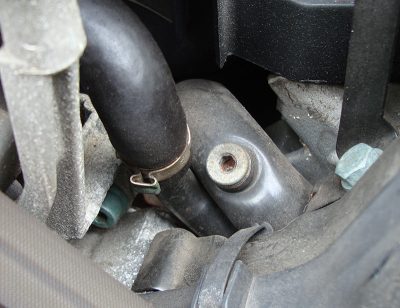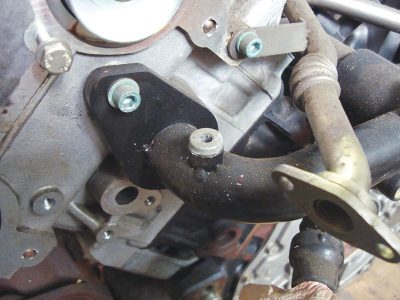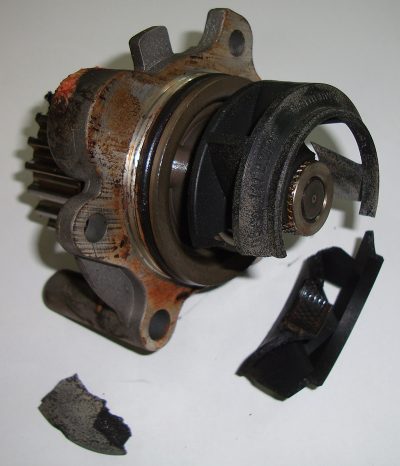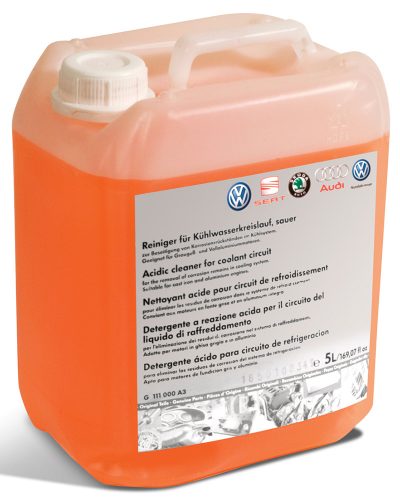In order for any engine to live a long life, it needs to operate in its own temperate zone. Continuous hot running, excessive temperature fluctuations, and overheating incidents all do damage. It’s your job to prevent these conditions.
Some of the most common and profitable service work you do is on the cooling system. Either you have the maintenance-conscious customer who has the coolant flushed at factory-recommended intervals, or the careless customer who brings you the vehicle when it’s running hot, or has overheated.
In the former case, you just have to make sure you do a thorough flushing job, and refill with the proper mix of O.E. antifreeze and distilled water while making sure that any air is bled out of the system. In the latter case, you’ll probably need to diagnose a problem, which can be anything from a bad water pump to a clogged radiator. With the cost of labor time and replacement parts, coupled with the unfortunate fact that your customers are enduring a downturn in the economy, you should be conscious of their budgets and fix the vehicle properly the first time with parts that will last. Cooling systems are nothing new, but here we’re going to make sure you have all the basics clear in your mind, and cover some of the special service procedures peculiar to Volkswagen vehicles.
Basics
To begin with, coolant is circulated throughout the engine where it absorbs the waste heat of combustion. It’s pumped through the radiator, where it dissipates this heat into the atmosphere, then is returned to the engine to be recirculated.
The basic components that perform this task are the water pump, thermostat, cooling system hoses, radiator, radiator cap, heater core, and, of course, the coolant itself. With so few components in the system, if any one were to fail it would have a major impact on cooling system performance. In addition, with modern high-performance engines, such as turbocharged models, new challenges to the job of keeping things cool have appeared.   
On Volkswagens, one specific addition is the auxiliary cooling system pump, which is designed to overcome restrictions from complex piping and complicated cooling system passages, and to get hot coolant to the heater core. Another common addition is an oil cooler, which exchanges heat between the engine oil and the coolant (as you may not have realized, oil not only provides lubrication, but also absorbs heat as it circulates). This helps keep the liquid lubricant’s properties from being altered by heat, which prevents the build-up of sludge and varnish.   
Cooling system temperatures vary from approximately 300 deg. F. in certain passages to below zero, depending on your location on the planet.
One way engineers have managed the problem of handling this broad range of temperatures is by keeping the system under pressure. If pure water were used as a coolant in an open system (which would naturally be at atmospheric pressure), the boiling point would be 212 deg. F. (100 degrees C.). If the engine exceeded this thermal limit, the water would start to boil off, and would also lose its ability to cool the engine because of bubbles. Sealing the system and adding antifreeze both raise the boiling point so that the engine can run at an efficient, optimum temperature. Cooling systems are pressurized to approximately 15 to 17 psi, depending on the application.
Another piece of the process we need to look at is sealing all the joints that have to withstand expansion and contraction as the engine heats up and cools down.
To control all of these factors, the engine must put out a “normal†amount of heat, and there must be proper coolant circulation, the correct coolant itself, and regulated cooling system pressure.
Roll Call
The heart of the cooling system is the water pump, which takes rotational mechanical energy and converts it into the movement of fluid. In a typical modern Volkswagen, the water pump is driven by the timing belt or chain instead of the accessory drive belt. So, if the belt were to snap there might be other damage to the valves, etc., but at least overheating from lack of water pump drive would be impossible because the engine wouldn’t be able to run. On the other hand, this design makes water pump quality even more critical. A seized pump can cause the “T” belt to break, resulting in catastrophic internal engine damage.
Modern water pumps use hybrid construction. They have steel shafts, but either have metal or composite pulleys, and, more importantly, impellers. Plastic impellers are pressed onto the shaft. If the impeller loses its grip, the pulley and shaft will continue to spin, but the impeller will not and coolant flow will be lost.
The thermostat restricts coolant flow until the system reaches normal operating temperature. So, if the thermostat were to stick closed, overheating would result. On the other hand, if the thermostat were to stick open, not only would normal operating temperature never be reached, but the engine would take much longer to warm up. This usually yields a code P0128 on OBD II-equipped vehicles.

The radiator, heater, and bypass hoses are made of fiber-reinforced rubber. With Volkswagen’s adoption of the auxiliary coolant pump and remote oil cooler, there are additional lines that over time will need to be serviced. As cooling system hose age they become soft, which eventually results in rupture. This rapid loss of coolant will cause an overheating condition very quickly. If a customer fails to notice it right away, expensive engine damage will be the likely result. You need to be checking all hoses at regular service intervals so you can replace them before they fail.   
The radiator is next in line. Coolant is pumped into one tank and moves through the core to the other. Along the way, it gives up its BTU’s to the aluminum tubes of the core, which in turn give them up to the atmosphere via the medium of the fins.
Neglected maintenance, or the use of improper antifreeze and hard water can result in blocked core passages. This can lead to an overheating condition may be difficult to diagnose. Another potential cause of reduced heat-exchange efficiency is anything that blocks airflow through the fins, such as leaves or an errant plastic bag.
Volkswagen was one of the first carmakers to adopt “PTR’s” (Plastic Tank Radiators) with aluminum cores, and they tend to last a very long time indeed — that is, given regular maintenance with O.E. antifreeze.   

Under Pressure
For some reason, techs tend to overlook the radiator cap, but it’s important. It regulates the pressure in the system that keeps the boiling point up, so a leaky cap can indirectly lead to overheating. Its other job is to provide for the physical fact that as coolant heats up, it expands.  
Volkswagen vehicles use a pressurized coolant reservoir, so that’s where the cap is located instead of on the radiator itself. Regardless, always test this important item when doing maintenance, diagnosis, or repair.
Testing, Testing, Testing…

A pressure test is traditionally the first step in checking out a cooling system (that is, if your visual inspection doesn’t reveal an obvious problem). It allows you to pump up the psi without getting the engine hot so you can be safer and more comfortable looking for leakage and soft hoses. Make sure the system will hold rated pressure for at least two minutes. While you’re at it, find out if the cap blows off at its specified rating.    
Sometimes it’s difficult to zero in on a leak. One good way is to add fluorescent dye to the radiator, run the engine for a sufficient time (this can take a while it might even make sense to have the customer bring the car back the next day), then have a look with your UV/black light. Seepage will jump out at you in bright yellow.   
You can use your exhaust analyzer to find compression/combustion leaks into the cooling system by picking up a sample above the radiator neck. But it’s easy to go too close and get coolant in the probe. A better way is to secure a large plastic bag around the neck with a rubber band, then punch a hole in the bag and insert the probe, keeping it a safe distance from the liquid.
There are also dedicated combustion gas leak detectors. Draw in some air that’s been trapped in the reservoir and you’ll see the tester’s fluid turn from blue to green if excessive CO2 (a byproduct of combustion) is present. An often overlooked step is to drain some coolant out of the system to allow a greater volume of air to build up for a more accurate reading.   

If compression is finding its way into the system, the most likely cause is a gap in the head gasket.   
When it comes to finding the cause of an overheating problem that’s the result of a low-flow situation, the process becomes a little deeper. Is it the water pump, restrictions from deposits, or a bad thermostat?
If you’ve got enough experience with known-good cars, scanning the system with a non-contact infrared pyrometer can tip you off to restrictions. You do have to know the path of the coolant through the system, however. For example, the pump forces coolant through the block first on the 1.8T, 2.0L and 2.8L engines. The rear coolant pipes divide the hot coolant between the heater core and the radiator. After passing through the radiator, coolant goes to the thermostat and back to the water pump.   
Any radiator should exhibit an even temperature drop across the core.
While the engine is idling from a cold start, you can use the coolant temperature sensor/sender for the PCM and the instrument cluster, which is usually mounted in the rear coolant pipes. Using a pyrometer and your scan tool look at how quickly coolant temperature rises at various points. You should be able to determine if there is coolant flow, or a blocked thermostat by checking temperatures at the rear coolant pipes, radiator and return hoses.
Hybrid water pumps can be an issue because of their steel shafts and plastic impellers. The symptom may seem counter-intuitive: You’ll probably see normal temperature at idle, but overheating on the road (just the opposite of what happens when an electric radiator fan stops working). Typically, what’s happening is that a loose impeller is still tight enough on the shaft to circulate enough coolant at idle, but when rpm increases, it slips. Rev the engine up and run through the coolant path you’re your pyrometer to see where the temperature is increasing and decreasing.
Maintenance

Volkswagen does not specify any particular mileage interval for coolant replacement, but the level should be checked at every service. Because it may be in there for a long time, the only reasonable antifreeze to use is Volkswagen’s own as it offers the extensive corrosion protection needed to meet these maintenance requirements. When performing any service work, use O.E. coolant G12, which was pink for years, but is now purple. Any time you’re replacing a water pump, hose, etc., it only makes sense to fill the system with fresh antifreeze and distilled water.
Another useful thing available from your Volkswagen dealer’s parts department is an acidic cleaner for flushing. Follow the instructions carefully.
Don’t underestimate the importance of bleeding the air out of convoluted modern cooling systems. Not only will trapped air ruin the intended flow pattern, thus causing hot spots, but it’ll increase corrosion dramatically. Volkswagen has made conmmendable efforts to avoid this situation. Its engineers have provided bleeder screws in logical places and special procedures that make eliminating air easy. Just don’t forget to do it.
Download PDF




0 Comments